
The family Scarabaeidae, as currently defined, consists of over 30,000 species of beetles worldwide; they are often called scarabs or scarab beetles. The classification of this family has undergone significant change in recent years. Several subfamilies have been elevated to family rank, and some reduced to lower ranks. The subfamilies listed in this article are in accordance with those in Bouchard (2011).
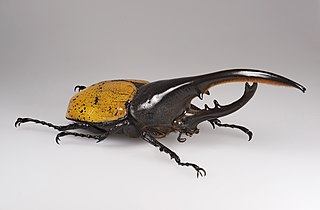
The Hercules beetle is a species of rhinoceros beetle native to the rainforests of southern Mexico, Central America, South America, and the Lesser Antilles. It is the longest extant species of beetle in the world, and is also one of the largest flying insects in the world.

Dynastinae or rhinoceros beetles are a subfamily of the scarab beetle family (Scarabaeidae). Other common names – some for particular groups of rhinoceros beetles – include Hercules beetles, unicorn beetles or horn beetles. Over 1500 species and 225 genera of rhinoceros beetles are known.

Dynastes tityus, the eastern Hercules beetle, is a species of rhinoceros beetle native to the Eastern United States. The adult's elytra are green, gray or tan, with black markings, and the whole animal, including the male's horns, may reach 60 mm (2.4 in) in length. The larvae feed on decaying wood from various trees.

Allomyrina dichotoma, also known as Japanese rhinoceros beetle, Japanese horned beetle, or kabutomushi, is a species of rhinoceros beetle.

The Atlas beetle is a very large species of beetle in the family Scarabaeidae, found in Southeast Asia. Males have three prominent horns. The species is named for Atlas, the giant of Greek mythology who supported the skies.

The elephant beetle is a member of the family Scarabaeidae and the subfamily Dynastinae. They are Neotropical rhinoceros beetles.

Goliathus regius, the Royal Goliath beetle, is a species of beetles of the family Scarabaeidae.

Actaeon beetle is a rhinoceros beetle of the family Scarabaeidae.
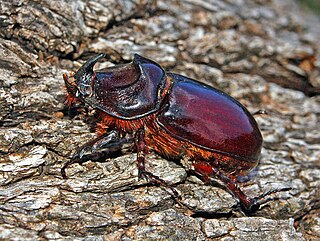
The European rhinoceros beetle is a large flying beetle belonging to the subfamily Dynastinae.

Xylotrupes gideon, the brown rhinoceros beetle, is a species of large scarab beetle belonging to the subfamily Dynastinae.

Dynastes satanas, the Satanas beetle, is a species of beetle belonging to the family Scarabaeidae. The name is sometimes misspelled as "satanus".

Megasoma is a genus of rhinoceros beetles. Commonly known as the elephant beetles, Megasoma species are found from the southern half of North America to most of South America.

Chalcosoma is a genus of Southeast Asian rhinoceros beetles. They are known as three horned rhinoceros beetles for their trident like horn. They are endemic to Southeast Asia.
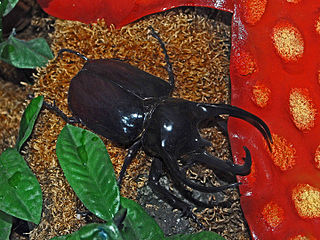
Chalcosoma chiron is a species of beetle in the family Scarabaeidae. This species can be found from Malaysia south into Indonesia and Thailand in East region. It was formerly known as Chalcosoma caucasus, a name which is a junior synonym and not valid.
Chalcosoma engganensis is a large (35–60 mm) and heavy beetle. The body is shiny black. The male has a sharp horn on the head. On each side of pronotum there are curved, forward directed horns. Across the head there is a short but powerful spike. This species differs from the normally developed specimens of the other Chalcosoma species in that horns are shorter, male can look a lot like small copies of Chalcosoma moellenkampi. The female lacks these horns and spikes, and is smaller.

Golofa imperialis is a species of rhinoceros beetles belonging to the family Scarabaeidae.
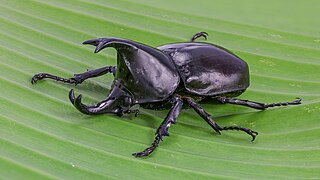
Xylotrupes socrates, commonly known as the Siamese rhinoceros beetle or fighting beetle, is a species of large scarab beetle belonging to the subfamily Dynastinae. It is particularly known for its role in insect fighting in Thailand.
Cyclocephala latericia is a beetle which belongs to the subfamily Dynastinae in the family Scarabaeidae.
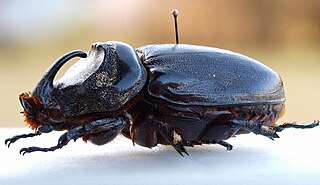
Oryctes gnu, commonly known as Malaysian rhinoceros beetle, is a species of dung beetle native to South Asian and South East Asian countries including: India, Pakistan, Sri Lanka, Philippines, Thailand, Philippines, and Vietnam. It is also introduced to many parts of the world.



















